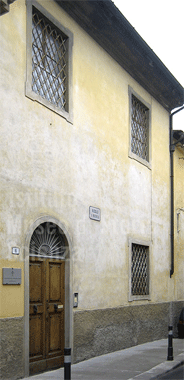This big convent, with a beautiful orangery, has been used in many different ways over the years. In the mid 14th century, the building was the site of the Monastery of San Michele Arcangelo, which hosted a community of Benedictine nuns, who had moved there from a previous site in the 'Gora' area, which is just outside of Porta al Borgo.
The convent was abolished in 1786 by the Bishop of Pistoia Scipione de' Ricci and the whole building was sold to Pietro Banchieri who then, using a plan created by the architect Stefano Ciardi, transformed it into a private building. The old spaces of the convent were destroyed, creating large common rooms, living rooms, bedrooms and service rooms. The little church at the corner of what is now Via Verdi was also destroyed. The new building was then sold to the Tolomei family who, for a reasonable price, gave part of it to a secluded order of Benedictine sisters and the rooms were readapted to the needs of a convent life, with cells, chapels, and communal dining rooms. The nuns moved here in 1889, after they were expropriated of the convent of Saint Mary of the Angels which is currently the site of Forteguerri Lyceum. In the entrance atrium, where the chariots could have access to the internal courtyard, a new church planned by the Florentine architect Riccardo Mazzanti was built. It was completed following the instructions of the nuns with a hall with three aisles in the reinassance style with cross vaults and an apsidal chapel with a barrel vault. The church, which up until 1928 was an oratory, still preserves its original plaster decorations and the pale colouring of its walls.
The nuns then moved into the site not only their works of art and their chemistry laboratory but also the spicery that ensured the religious community a certain income. The wonderful orchard inside the convent gave them the possibility to grow medicinal herbs.
During this period, a certain entrepeneurial spirt arose in the nuns, Maria Cristina Carobbi, a chemist who was herself abbess at the convent for twelve years from 1892 to 1904, guarded the secret and exclusive formula of the 'Tisana alle erbe salutari' (healthy herb tea). This mixture was considered prodigious for the treatment of gout and was very well known throughout Europe and was indeed requested by many different chemists from various European countries.
Along with the herbs, the nuns also used to grow wild oranges, which still currently grow in the orchard, producing preserves, candied fruit, and above all the traditional 'Rosolio di China' (Cinchona liqueur), about which records have been found as far back as the 18th century. Nowadays, the nuns can still support themselves by usng these ancient recipes, living fully the benedectine spirit of 'ORA ET LABORA' (pray and work) helping us to get to know the traditions and indeed flavours of the past.
In the entrance atrium, where the chariots could have access to the internal courtyard, a new church planned by the Florentine architect Riccardo Mazzanti was built. It was completed following the instructions of the nuns with a hall with three aisles in the reinassance style with cross vaults and an apsidal chapel with a barrel vault. The church, which up until 1928 was an oratory, still preserves its original plaster decorations and the pale colouring of its walls.
The nuns then moved into the site not only their works of art and their chemistry laboratory but also the spicery that ensured the religious community a certain income. The wonderful orchard inside the convent gave them the possibility to grow medicinal herbs.
During this period, a certain entrepeneurial spirt arose in the nuns, Maria Cristina Carobbi, a chemist who was herself abbess at the convent for twelve years from 1892 to 1904, guarded the secret and exclusive formula of the 'Tisana alle erbe salutari' (healthy herb tea). This mixture was considered prodigious for the treatment of gout and was very well known throughout Europe and was indeed requested by many different chemists from various European countries.
Along with the herbs, the nuns also used to grow wild oranges, which still currently grow in the orchard, producing preserves, candied fruit, and above all the traditional 'Rosolio di China' (Cinchona liqueur), about which records have been found as far back as the 18th century. Nowadays, the nuns can still support themselves by usng these ancient recipes, living fully the benedectine spirit of 'ORA ET LABORA' (pray and work) helping us to get to know the traditions and indeed flavours of the past.
 In the entrance atrium, where the chariots could have access to the internal courtyard, a new church planned by the Florentine architect Riccardo Mazzanti was built. It was completed following the instructions of the nuns with a hall with three aisles in the reinassance style with cross vaults and an apsidal chapel with a barrel vault. The church, which up until 1928 was an oratory, still preserves its original plaster decorations and the pale colouring of its walls.
The nuns then moved into the site not only their works of art and their chemistry laboratory but also the spicery that ensured the religious community a certain income. The wonderful orchard inside the convent gave them the possibility to grow medicinal herbs.
During this period, a certain entrepeneurial spirt arose in the nuns, Maria Cristina Carobbi, a chemist who was herself abbess at the convent for twelve years from 1892 to 1904, guarded the secret and exclusive formula of the 'Tisana alle erbe salutari' (healthy herb tea). This mixture was considered prodigious for the treatment of gout and was very well known throughout Europe and was indeed requested by many different chemists from various European countries.
Along with the herbs, the nuns also used to grow wild oranges, which still currently grow in the orchard, producing preserves, candied fruit, and above all the traditional 'Rosolio di China' (Cinchona liqueur), about which records have been found as far back as the 18th century. Nowadays, the nuns can still support themselves by usng these ancient recipes, living fully the benedectine spirit of 'ORA ET LABORA' (pray and work) helping us to get to know the traditions and indeed flavours of the past.
In the entrance atrium, where the chariots could have access to the internal courtyard, a new church planned by the Florentine architect Riccardo Mazzanti was built. It was completed following the instructions of the nuns with a hall with three aisles in the reinassance style with cross vaults and an apsidal chapel with a barrel vault. The church, which up until 1928 was an oratory, still preserves its original plaster decorations and the pale colouring of its walls.
The nuns then moved into the site not only their works of art and their chemistry laboratory but also the spicery that ensured the religious community a certain income. The wonderful orchard inside the convent gave them the possibility to grow medicinal herbs.
During this period, a certain entrepeneurial spirt arose in the nuns, Maria Cristina Carobbi, a chemist who was herself abbess at the convent for twelve years from 1892 to 1904, guarded the secret and exclusive formula of the 'Tisana alle erbe salutari' (healthy herb tea). This mixture was considered prodigious for the treatment of gout and was very well known throughout Europe and was indeed requested by many different chemists from various European countries.
Along with the herbs, the nuns also used to grow wild oranges, which still currently grow in the orchard, producing preserves, candied fruit, and above all the traditional 'Rosolio di China' (Cinchona liqueur), about which records have been found as far back as the 18th century. Nowadays, the nuns can still support themselves by usng these ancient recipes, living fully the benedectine spirit of 'ORA ET LABORA' (pray and work) helping us to get to know the traditions and indeed flavours of the past.


